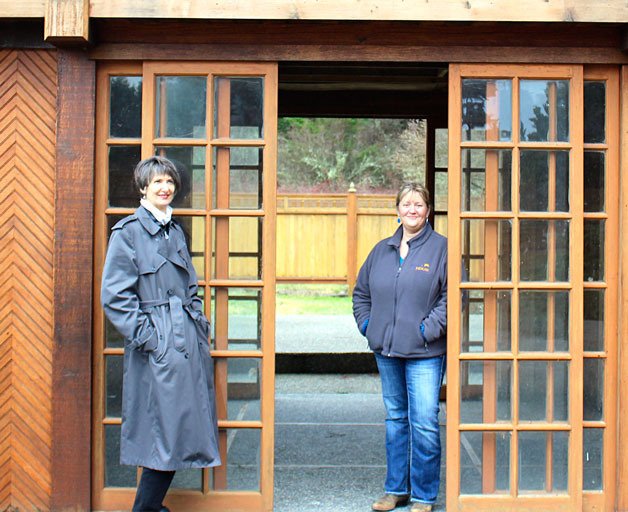Unaccompanied homeless youth on Whidbey may soon have access to the island’s first temporary housing facility specifically designed to meet their needs.
Ryan’s House for Youth, the small Freeland-based nonprofit which serves youth ages 13-24, is looking to purchase the former Countryside Inn just south of Coupeville on Highway 20 with plans to convert the space into a center complete with expanded drop-in services as well as a number of temporary living quarters.
Ryan’s House currently operates out of a small office space in Freeland which, although larger than its previous quarters, it has outgrown.
According to Lori Cavender, executive director and founder, approximately 15-20 youth stop by the center each day. She estimates that, if the organization is successful in purchasing the inn, that number will increase significantly as youth on Central and North Whidbey will have better access to and increased awareness of the organization.
Cavender noted that while most South End youth are aware of Ryan’s House, many in other areas of the island are not. She said she expects that young people from the South End will continue to come to Ryan’s House regardless of its location. The inn’s location across the highway from Island Transit will also make it accessible to youth from various areas of the island, she added.
In 2015, 26 of the 104 unaccompanied homeless youth identified by school district homeless liaisons were from the Coupeville area.
From South Whidbey middle and high schools, eight homeless youth were identified by district liaisons. Cavender said 14 South Whidbey young people ages 12-24 visited the drop-in center in 2015, many of whom had already graduated from high school.
Cavender explained that 104 is likely an underrepresentation, as some students decline to disclose their living situations and other youth may have graduated or no longer be enrolled in school.
In addition, Cavender noted that her daughter, a former South End student, knew of many fellow students who were homeless but had not notified district liaisons.
The circumstances under which young people become homeless are numerous, Cavender said. Some are expelled from the home due to a family’s disapproval of a youth’s gender identity or sexual orientation; other young people leave due to an unsafe environment caused by an adult’s addiction or mental illness; still others are expelled when their families are simply unable to afford to care for them.
The opportunity for these young people to have a safe, warm space to stay and gain life skills would be invaluable, Cavender said.
The new digs would also allow the organization to significantly expand its offerings, most notably with the transitional housing units, which would be granted to homeless youth on a first come, first served basis.
Although the organization also operates a successful host family program for homeless youth, the list of youth awaiting placement is consistently lengthy, Cavender said.
She added that, for young people with severe mental illness, host family placement is not possible. The temporary living facility would be a boon to them, in particular.
“We could put kids in [the beds] tomorrow which is amazing to me,” Cavender said.
There are four double rooms and 10 single rooms in addition to three suites, or apartments. Each of the motel rooms includes a small table or desk, a bed(s), bathroom and refrigerator.
One of the apartments will likely be home to a full-time, live-in staff person, allowing the facility to operate 24/7. One or both of the others could potentially be rented out.
Its 7.5 acres of land offer potential for crops, and possibly even a seasonal corn maze, both of which could potentially generate a bit of income for the organization.
A spacious common area, in which the drop-in center will be located, contains a laundry room — there’s a second laundry room adjacent to the temporary living quarters — as well as a large kitchen and bathroom. It also provides ample space for the organization’s clothing and supply closet.
Adjacent to the kitchen is a former greenhouse, which Cavender envisions as a space for a youth health clinic. One nurse practitioner has already offered to volunteer services, Cavender said.
The property also contains office space from which the nonprofit can conduct its case management services.
The property fell into foreclosure late last year. Although other offers have come in, Cavender said the seller, SaviBank, has turned these down in order to facilitate the nonprofit’s purchase.
Brokers Rick Chapman and Marchele Hatchner are providing their services pro bono.
“I see the interaction being more family-like,” Hatchner said, stressing the importance of such a facility in the community.
The seller, SaviBank, has offered a $75,000 contribution. The purchase price is $525,000, of which the organization was $399,000 shy as of Wednesday. The deadline to raise the remaining funds is Feb. 29.
“I’m not losing hope,” Cavender said. “I’m just seeing the time ticking away.”
In order to raise the remainder of the funds, Ryan’s House has set up a capital campaign. Visit www.ryanshouseforyouth.org/capital-campaign.html for more information.



